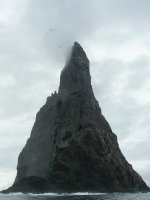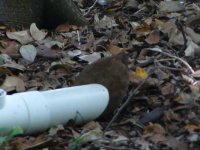
Ball's Pyramid is located about 23 kilometers SSE from Lord Howe Island, Australia. With a height of at least 552 meters, it is, apparently, the world's tallest sea stack, a remnant of a huge volcano. This place is teaming with fine seabirds. The attached pictures show it from the NE, as approached by boat coming from Lord Howe, and from the SW. The latter reveals that this sea stack has a much broader appearance from the SW.



















